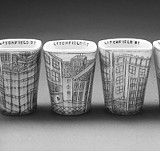[
{
"name": "500x250 Ad",
"insertPoint": "5",
"component": "15667920",
"parentWrapperClass": "",
"requiredCountToDisplay": "1"
}
]
"The Ceramics Program is vital because at its center are dynamic faculty who embody the integrity and core values we associate with expertly handcrafted objects," writes Michael Rogers, chair of the School for American Crafts at Rochester Institute of Technology. The faculty Rogers refers to are Rick Hirsch and Julia Galloway, whose work is the focus of Convergence of Temperaments, currently on view at Roberts Wesleyan College's Davison Gallery.
The exemplary work of these two artists is also very telling in terms of contemporary debates about how particular works --- or more precisely, how particular kinds of work --- are received in our culture. The words "ceramics," "crafts," and "handcrafted" have certain connotations in relation to the arts.
Ceramics are often synonymous with vessels and are therefore usually considered utilitarian. (Both Hirsch and Galloway consciously make this an issue in their work.) Similarly, "craft" and "handcrafted" imply a certain kind of labor, a labor that is concerned with the making of an object, and is not necessarily imbued with the conceptual, but rather with utility.
In the Critique of Judgment, Immanuel Kant distinguished art from craft, solidifying an already entrenched prejudice. He declared that "[t]he first is called free art, the second could... be called mercenary art." Free art, or what we sometimes call "fine art" (or "Art" with a capital "A"), is associated with a purpose that serves itself. Mercenary art, which we call craft, is seen as labor and thus, as defined by Kant, is "disagreeable" or even "burdensome" because it reminds us of our everyday banal existence.
Of course, the labor that is expressed in a painting or a sculpture is not technically any different than that which is expressed in ceramics. So, the difference lies in the way we see the purpose of the object. Are we supposed to use the vessel or just look at it? It seems our culture values the contemplative above the useful and, in the process, associates the former with the privilege of thought and free time and the latter with work.
Both Hirsch and Galloway address and confound these predicaments by the physical presence of their work. Hirsch's ceramic bodies are definitely containers and objects of use, as their titles imply --- mortars and pestles, bowls and ladles --- sitting on multiple bases. Indeed, even the bases themselves constitute a specific purpose. The mortal and pestles could be used but their surfaces and presence resonate more as antique artifacts meant to be revered and cherished (objects of a bygone culture, perhaps?) while large bowls with shallow interiors defy their use value.
Hirsch's work echoes a history of purposeful objects and materials while at the same time addresses those materials in their natural state. The base for a mortar and pestle, although ceramic, looks like metal that has been allowed to rust and the mortar, with its convoluted surfaces, seems as if it were wrenched from nature itself.
More obviously functional, Galloway's vessels are surfaces covered with organic decorations that wend their way around the bodies of her pots. Additionally, architectural scenes on a series of cups remind us of the spaces we inhabit and the things that are kept or manufactured within. In the cup series, the buildings are literally part of the neighborhood where she lives and makes her pots. It is a wonderful poetic gesture about the objects in our lives, their integration with our own bodies, and the rituals we perform daily.
Kant wanted art to be free of the constraints of the everyday and thus, disconnected from our desiring bodies. But in the end, all we have is desire. And the wonderfully handcrafted objects by Hirsch and Galloway remind us of our need for the everyday, the social, and for our bodies and minds to be nourished and caressed by what we are and what we make.
Convergence of Temperaments: Rick Hirsch and Julia Galloway is on display at the Davison Art Gallery at Roberts Wesleyan College, 2301 Westside Drive, through November 6. Hours: Monday trough Friday 9 a.m. to 10 p.m. 594-6000, www.roberts.edu
Speaking of Convergence Of Temperaments, Roberts Wesleyan College
-
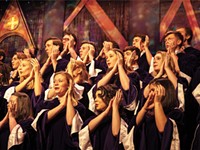
CHORAL | St. Olaf Choir
Jan 29, 2020 -
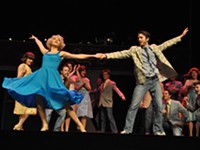
Theater Review: "West Side Story" at Roberts Wesleyan College
Jan 17, 2015 -
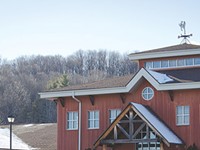
On the streets where you live
Mar 27, 2013 - More »
Latest in Art
More by Alex Miokovic
-
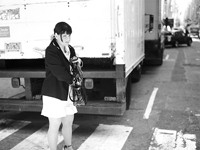
Larry Merrill at M. Early Gallery
Dec 6, 2006 -
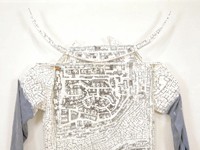
"Kim Jones: A Retrospective"
Nov 29, 2006 -
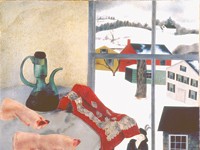
"My America" at the MAG
Nov 8, 2006 - More »
More by Heidi Nickisher
-

Larry Merrill at M. Early Gallery
Dec 6, 2006 -

"Kim Jones: A Retrospective"
Nov 29, 2006 -

"My America" at the MAG
Nov 8, 2006 - More »
